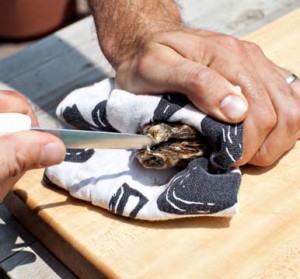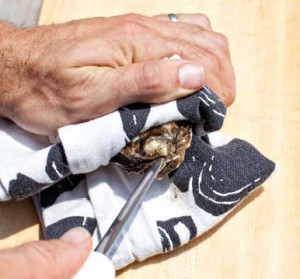
U.N. Food & Agriculture Organization
Oyster meat is packed with omega-3 fatty acids, so they’re a great choice to promote healthy growth and development in kids.
Shopping Tips
- Look for live oysters with a fresh, sea salt smell. Avoid individuals that give off a sulforous or rotting odor.
- If the shell is slightly open, the oyster may have died. Tap the outside of the shell-if the oyster shuts, it is likely still alive. If it stays open, avoid eating.
- Keep the oysters covered with a paper towel in your fridge, and eat soon after purchasing.
Cooking Tips:
*Chef’s tips from Barton Seaver
Shucking oysters for cooking and eating raw is not complicated but does take some practice. The best shuckers in the world are a true marvel to watch. But with just a well placed knife and a little patience, the pulsing briny world of the oyster can be revealed by the home cook with the same results.
1. Using a towel to protect the hand that holds the oyster, find the hinge at the narrow endof the oyster and insert the tip of a shucking knife between the two shells.
2. Wiggle the knife until it is firmly lodged between the shells, then twist the knife to pry the top and bottom shells apart.
3. Wipe the knife on the towel to remove any mud or shell fragments.
4. Slide the knife along the underside of the top shell to release the meat of the oyster. Be careful to keep all of the flavorful liquid. Discard the top shell.
5. Slide the knife under the bottom of the oyster to release it from the lower shell.





More information on Oysters
Oysters are not just sustainable, they actually help to restore depleted ecosystems. Unlike some farm-raised seafood, whose escape can wreak devastating effects on their wild brethren, oysters freely cast their spawn into the surrounding waters, helping to replenish populations, and are among the most important foundations of coastal habitats. Like mussels and clams, oysters are filter-feeders, filtering water through their bodies and removing tiny bits of nutrients. This helps to keep the waters clean, which then enables sunlight to reach the seafloor, thus spurring plant growth, which then enables the young of many ocean species to hide from predators, which leads to a healthy ecosystem*.
Farmed oysters also provide a great opportunity for watermen to make a living. In many areas where oysters are a traditional source of income, farming the seas is about all that is left. These communities would otherwise disappear, their residents moving away to find other jobs. *
Recipes
Oyster Stew with Sweet Potatoes and Bacon*
Oyster Burgers with Special Slaw
*Images and recipes reprinted with permission from For Cod & Country © 2011 by Barton Seaver, Sterling Epicure, an imprint of Sterling Publishing Co., Inc.